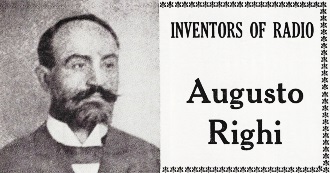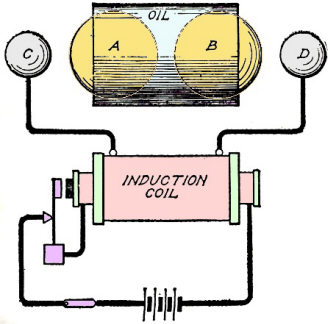Inventors of Radio: Augusto Righi |
|
I don't know about you, but I had never heard of Augusto Righi before seeing him honored in this "Inventors of Radio" feature in a 1958 issue of Radio−Electronics magazine. Reportedly Guglielmo Marconi was an informal student of Righi's when he, Righi, taught at University of Bologna. Augusto is credited as being the first to generate using the apparatus shown in the article. Interestingly, as was customary in the era, the frequency of 12 GHz was reported as 12 kmc, or 12 kilomegacycles. He also is recognized as being the discovered of magnetic hysteresis. Along with many other scientific endeavors, Righi worked on Special Relativity in his later years, and was considered one of the few people who understood the concepts and equations. He lived from 1850 to 1920, which is pretty good for the era. Inventors of Radio: Augusto Righi
Augusto Righi was a brilliant Italian basic physicist and educator who sought facts for the sake of science rather than publicity. This has resulted in his being an unknown in this missile age. Both myself and others have diligently sought information on Righi but, with the exception of short biographies, very little information can be found in English. Yet, as a research scientist and educator, he laid much of the foundation for today's electronics as well as other physical sciences. As Guglielmo Marconi was a student at Bologna, while Righi was professor, they became acquainted and Righi was a great help to Marconi, both in encouragement and actual experimentation. Augusto Righi (sometimes spelled Richi or Rigi) was born in Bologna, Italy, on Aug. 27, 1850. He attended the Bologna University, where he received his diploma. In 1873, he became professor at the Bologna Technical Institute, later to become principal extraordinary at Palermo University where he taught up to the time of his death in 1920. He received many honors and several medals from universities in Italy and elsewhere. In 1872, he was natural science ambassador to the King of Italy. In Rome, he published the results of his theoretical experiments, in 250 scientific papers, embracing almost all subjects in the realm of the physical. Besides his basic researches in electromagnetic waves, he made two practical contributions to wireless with his oscillator and detector, the basic equipment used in Marconi's first experiments. It was remarked by a veteran engineer that "before describing methods Marconi devised by which he realized his ambition, it is advisable to refer to the work of those pioneers who influenced Marconi in his early experiments, and of whose work he had knowledge: Maxwell, Hertz, Righi and Branly." One disadvantage of Hertz's radiator lay in the fact that the sparks in a short time oxidized the little knobs and roughened their surfaces, resulting in irregular action. Professor Righi overcame this difficulty by partly enclosing two metal spheres, A and B in the sketch, in an oil-tight case, the inner hemispheres being immersed in petroleum with only a minute gap between them. In a line with these spheres are ranged two smaller spheres, C and D. It is between A and B in the oil gap that the oscillatory spark takes place, the other two sparks serving merely to charge the large spheres. This arrangement not only produced a more constant spark by preventing pitting electrodes but greatly extended the range of wavelengths which it was possible to employ in investigations of this character. The dimensions of the oscillator could thereby be reduced and the amplitude of the oscillations increased greatly as higher potentials could be reached before the energy was released by discharge. Righi obtained oscillations at 12 kmc by using 8 millimeter spheres for A and B. He contributed a new "detector" by cutting thin lines on the back of a mirror, dividing the metallic surface with a diamond point into narrow unconnected strips. This provided a spark distance much finer than could be attained by a micrometer gap, as used by Hertz, hence affording greater sensitivity and greatly increasing the distance, Hertz covered only a few meters. The frog's leg, to which we owe the discovery of electric current, had been previously tried by others but had given even poorer results as a detector. It is a strange coincidence that it took at least 50 years for the electronic industry to go back to centimeter waves. Later researchers added antenna and ground to their oscillators, lowering their frequencies greatly and therefore lengthening the wavelengths. In his youth, Righi did a great deal of research in the basic relationships between mechanical, electrical and magnetic forces, endeavoring to prove them all of one origin. In this he failed but, considering the status of atomic physics nearly a century ago, this was understandable. However, he did accomplish much in extending Faraday's research on electric and magnetic forces, Righi did extensive research on the Kerr cell, which is now used in some facsimile systems, and discovered the rotation of the polarization plane with different light frequencies. This in turn led him to the discovery of the photo-electric effect of various materials and then on to work on ionized gases. From 1915 to his death, he devoted his researches to the theory of relativity, being one of the few physicists of that day who could understand Einstein's mathematics. His principal scientific papers were: "The Optics of Electric Oscillations," 1897; "The Motion of Ions in the Electric Discharge," 1903; "Telegraphy without Wires" (in collaboration with B. Dessau), 1903; "The Modern Theory of Physical Phenomena," 1904; "On the Hypothesis of the Electrical Nature of Matter," 1907; "New Views of the Intimate Structure of Matter," 1910; "Radiating Matter and Magnetic Rays," 1910; "The New Physics," 1911; "Ionomagnetic Rotation," 1915; "Electro-Atomic Phenomena under the Action of Magnetism," 1918. References: Enciclopedia Italiana, 1936 Cyclopedia of Applied Electricity, 1911 Florian Cajori, History of Physics
Posted |
|

 Dexter S. Bartlett
Dexter S. Bartlett 